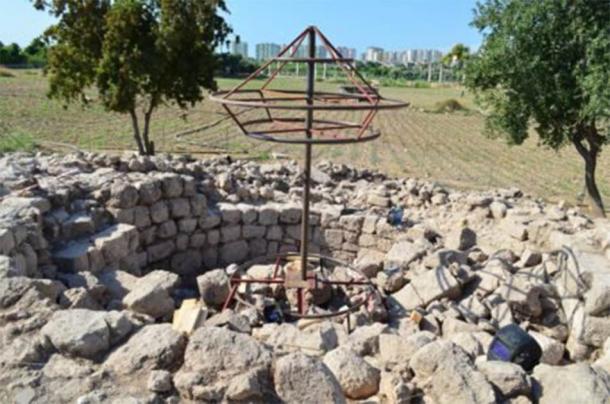
Tomb of Ancient Greek Poet and Astronomer Found in Turkey
Throughout time some people are remembered after they die for their achievements. But some individuals are celebrated both in life and death and they are especially important. What archaeologists recently found in Turkey is a large memorial tomb dedicated to one of those people, the ancient Greek poet and astronomer Aratus. Aratus was a didactic poet who wrote verses about astronomical subjects, which were once very influential. The tomb of the ancient Greek poet was found among the ruins of Soli Pompeiopolis, a Hellenistic and Roman city in ancient times.
A team led by Remzi Yağcı of Dokuz Eylül University found the tomb of the ancient Greek poet three years ago. It was unearthed during excavations in Soli Pompeiopolis, which is now in Mersin, in southern Turkey. The Greek city, originally known as Soli was founded by Rhodian settlers in about 700 BC. It first prospered under the Seleucids and later under the Romans until it was destroyed by an earthquake in the 6 th century BC. The city’s name was changed from Soli to Soli Pompeiopolis, in honor of Pompey the Great, who used it as a base during his campaigns against the Cilician pirates (67 BC).

The emerging outlines of the memorial tomb of the ancient Greek poet Aratus. (Greek City Times)
The Lost City of Soli Pompeiopolis and the Ancient Greek Poet
Archaeologists in recent years have made many significant finds among the ruins of Soli Pompeiopolis including “a theatre, as well as the city’s harbor and aqueduct,” reports the Greek City Times. Three years ago, they made perhaps the most remarkable discovery, yet. Deniz Kaplan, an academic from Mersin University’s archaeology department, stated that archaeologists “encountered a circular structure surrounded by two rows of hexagonal shape,” according to the Greek City Times. To their great surprise, they had found the memorial tomb of the famous ancient Greek poet Aratus.

A Latin copy of the ancient Greek poet Aratus’s primary work: Phaenomena. (Biblioteca Europea di Informazione e Cultura / Public domain)
Aratus was born in Soli in about 315 BC. He was a didactic poet, which means he wrote verses that instructed people on skills, science, or philosophy. The Encyclopedia Britannica states that “The Phaenomena, a didactic poem in hexameters, is his only completely extant work.” The most important part of Aratus’s work is the versification of part of an astronomical treatise by Eudoxus of Cnidus (c. 390–c. 340 BC), which includes a description of the constellations. The second part of the Phaenomena focused on weather forecasts. Aratus was a Stoic and his work was very influential on the development of Greek astronomy, among his many admirers was the Roman author and statesman Cicero.

A plaque dedicated to the ancient Greek poet Aratus. (Public domain)
- The Tomb of Archimedes, Genius of Syracuse, Concealed by a Naiad
- The Poetry of Gods by Enheduanna - The First Known Female Writer
- Ancient Pattern Poetry – A Visual Story
Ancient Greek Poet Aratus Was Very Influential
The ancient Greek poet Aratus spent much of his career in the courts of leading Hellenistic monarchs such as Antiochus I. He probably died in Macedonia in 245 BC. His tomb was located some 450 feet (150 meters) from a stoa, a column lined avenue in Soli. Today, the memorial to this ancient Greek poet is not far from the high-rise buildings of the modern city of Mersin, Turkey.
The archaeologists were only permitted to continue work on the tomb early this summer (2020). In August 2020, the team reached the inner wall of the burial tomb. Yağcı is quoted by the Greek City Times as saying “This place looks like a crater and has a circular plot worthy of an astronomer. We have also come across a solid and large, monumental structure.” It is believed that there were arches over the memorial tomb. Message to Eagle reports that “the team is determined to unearth entirely the tomb of Aratus and whatever there is left of Soli ancient city.” Clearly the cultural authorities are very proud that the tomb of a famous ancient Greek poet was found in Soli and this is just the beginning!
NASA Names Moon Crater After Ancient Greek Poet Aratus
Greek City Times reports Yağcı as saying that, “For the first time, a memorial tomb has been unearthed linked to the archaeology of the ancient city of Soli Pompeiopolis.” It is helping researchers to better understand the urban landscape of this ruined ancient city. The tomb of the ancient Greek poet Aratus was a unique feature in ancient Soli and demonstrates that he was highly respected and celebrated for his work. He was not only famous in his own time but also in modern times. NASA named a crater on the moon after the ancient Greek poet Aratus in recognition of his achievements.
As the work progresses, the outlines of the tomb are becoming clearer. It is hoped that the recent discovery can boost interest in the ruined city. The Greek City Times reports Yağcı as saying that “This find brings dynamism to the ancient city and can influence tourism in the region – for both those interested in cultural heritage and general visitors to the region.” Furthermore, it is hoped that the discovery of the tomb of the ancient Greek poet Aratus can distinguish ancient Soli Pompeiopolis as a UNESCO World Heritage site.
Top image: The ancient ruins of Soli Pompeiopolis, where the large memorial tomb of the ancient Greek poet Aratus was discovered. Source: Vassia Atanassova - Spiritia / CC BY-SA 3.0
By Ed Whelan















